Structured data. Schema. Markup. Rich snippets. No corner of content and search engine marketing is more jam-packed with jargon, tech-speak and insider language.
We’re going to lift the veil and explain what it all means and how it’s valuable to you as a marketer.
Schema is a markup language that webmasters use to add information about your content to that page’s HTML. Google, Microsoft, Yandex and Yahoo collectively created schema to provide their users with better search engine results.
Theoretically, if your website and content are perfectly built, organized and optimized, structured data isn’t necessary.
But let’s face it: Perfect structure, organization and optimization just isn’t possible.
That’s what makes the concept of structured data so helpful. Even if your site isn’t perfect, schema helps to produce the most important information in search results.
I’m going to cover, on a very basic level, what structured data is, why it’s important and how to use one of the best-structured data tools around.
What is structured data?
We know that what search engines see and what readers see is completely different.
While we see this:

The search engines see this:
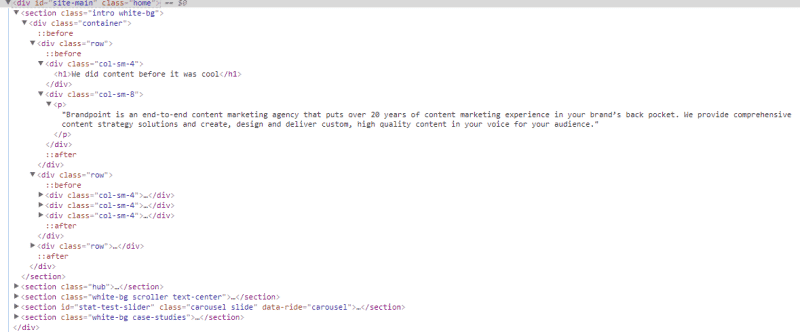
The code features instructions for how that information should appear in a browser and gives web crawlers an idea of what’s on the page.
Structured data goes one step further. Structured data involves embedded code tags (often referred to as markup) that tell Google and other search engines the information you want a search to return.
This allows you to indicate the most important pieces of information you want presented when someone searches for it.
For example (and because I love pumpkin pie), I searched “pumpkin pie” on Google and here are the results:
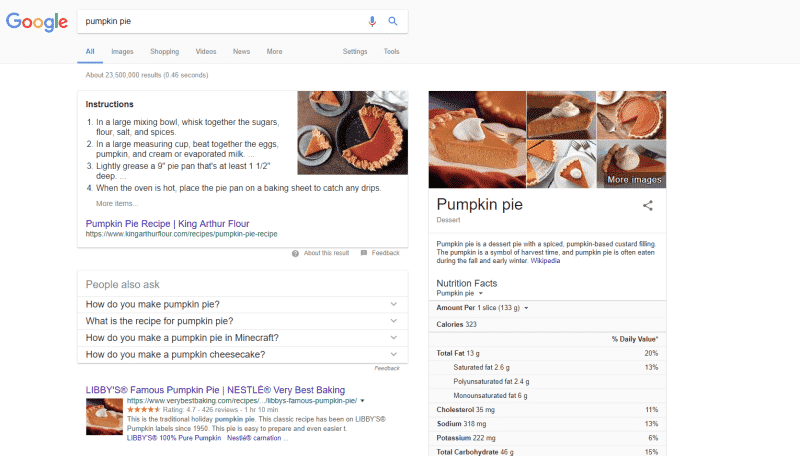
As you can see, there’s a featured snippet at the top and there’s a Wikipedia widget along the right. Libby’s Famous Pumpkin Pie, the first “regular” search result, features a star rating and bake time. These are all examples of rich snippets and they’re the result of structured data.
What structured data can (and can’t) do
Structured data markup can do a lot of things for your content, most notably when it comes to search. It doesn’t fix a poorly optimized site (or crappy content) but it can help you present more favorable information in the search engine’s results. In fact, Search Engine Land suggests structured data is one of the eight SEO trends primed to make a huge impact in 2018.
Resources and tools like Schema.org and Google’s Structured Data Markup Helper provide a way to embed markup tags to important elements on your site and help search engines easily identify the pieces of information most valuable to their users.
The biggest benefits of structured data is a chance to increase the click-through rate. Rich snippets, such as the pumpkin pie example above, are much more striking and appealing to the eye, so your content stands out in search results
Schema can also boost your organic click-through rate by up to a substantial 30 percent, according to Search Engine Land. That means you could be encouraging 30 percent more visits to your website by simply entering some code and potentially generating rich snippets.
Depending on how detailed you want to get, structured data can improve your chances for ranking (somewhere) for related keywords. This is especially important for local search. For example, if you run a small music store and also carry used records, someone searching “used record shop” in your area may or may not include you in the search results, depending on how accurately and completely marked up your website.
Structured data DOESN’T, however, have any impact on organic search ranking. Structured data has no impact on how your content looks, feels or functions. It only affects how and when it might appear in search.
[RELATED: Improve your content’s chance at organic ranking (and earning a featured snippet) by improving its quality.]
How to implement structured data
As a marketer, structured-data competency and implementation probably wasn’t in your job description. But it’s still helpful to know what it is and the tools that can make it easy for you. I’m going to walk you through a simple step-by-step process for implementing structured data, using one of our blog posts (“How to Create Comprehensive Content”) as an example.
Step 1: Use the Structured Data Markup Helper
Schema.org is the most robust structured data map available. Google, Microsoft (Bing), Yahoo and Yandex all teamed up to build this incredibly detailed layout and it informs all the other tools. But it can be complex to read if you’re not a developer.
Google’s Structured Data Markup Helper makes it easier to build and implement structured data. This tool is easy to use and allows you to tag the information that you want to mark up and then shows you where to place that code in your content.
To start, select a data type:
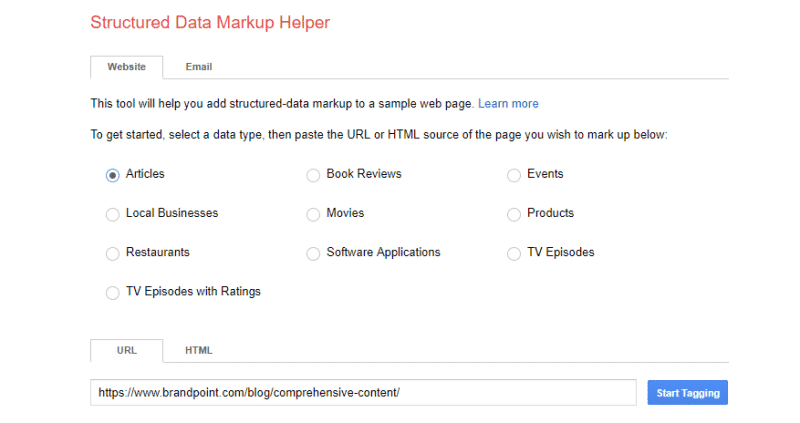
Select your data type (since we’re marking up a blog, we chose “Article”) and copy the blog’s URL into the bar below. Then click “Start Tagging.”
Right click or highlight the different elements (image, author, data, etc.) on that page and assign them to the appropriate data item:



Do this until you’ve identified everything you want to markup. The Data Items window should look something like this:
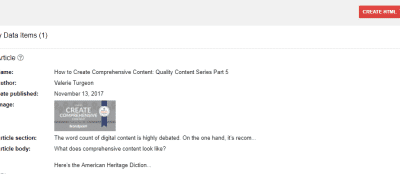
Not everything in this area needs to be filled out, but you have to make sure that the current blog post you’re marking up has the same information as every blog post you mark up. This will make sure you have the proper code to add to your blog template.
After you have highlighted all the text you want to code, select the “Create HTML” button in the top-right corner of the window. This will present the HTML tag with the Microdata Markup we will use to add to our blog template.
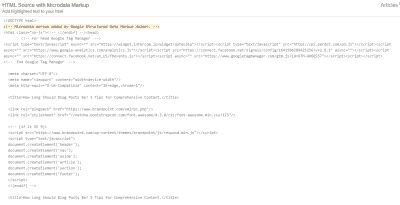
Step 2: Add the markup to your WordPress blog template
Now that you’ve marked up your content, you’re ready to add the HTML tag(s) to your WordPress template. This is where it really pays to have a developer by your side.
In a standard WordPress website, there are templates for every type of page design on your site. This is where you’ll place the code. You can find the templates by selecting the “Appearance” bar in the left column. Select “Editor,” and this will bring you to your site’s themes. In the right column is a list of all the templates for your site. Select the template that represents your blog posts; for this example it is called “Single Post.”
Take the code that the Structured Data Markup Helper generated and place it into the template. Now, whenever you create a blog within WordPress or your content marketing platform, the structured data will already be embedded. You can go ahead and do this for all web pages across your entire site.
Pro-Tip: Use WordPress plugins. If you’re short on development resources, there are a host of rich snippet tools and plugins to make it easier to implement structured data.
Step 3: Test the code with Google
After you have added the code, it is time to test the URL and make sure the code is rendering correctly. You can find the Structured Data Testing Tool in Google Webmaster. Add the URL in the box provided and select “preview.” Google will run a short crawl on the structured data and alert you to any errors or issues with the code.
Take a deep breath
This might seem like a lot and, to be honest, it can be pretty cumbersome. But implementing structured data can help you control the information that appears in search and help you generate more rich snippets and increase your click-through rate.
As I mentioned earlier, structured data isn’t going to fix bad content or a poorly optimized site. But it can be the “icing on the cake” if implemented correctly.
Chris Kinney
Latest posts by Chris Kinney (see all)
- Maximizing the Effectiveness of Your Content for Google’s Search Interactive Encounter - September 12, 2023
- Super Guide To Customer Acquisition - June 30, 2021
- How to Repair Any Digital Device Fault - November 3, 2020






Introducing the aspect of schema and structured data is really useful. It’s going to help businesses owners present their content in a manner that will attract higher traffic. Their agile planning and analytics will improve due to a more focused approach. A high quality and optimized site will get even better.